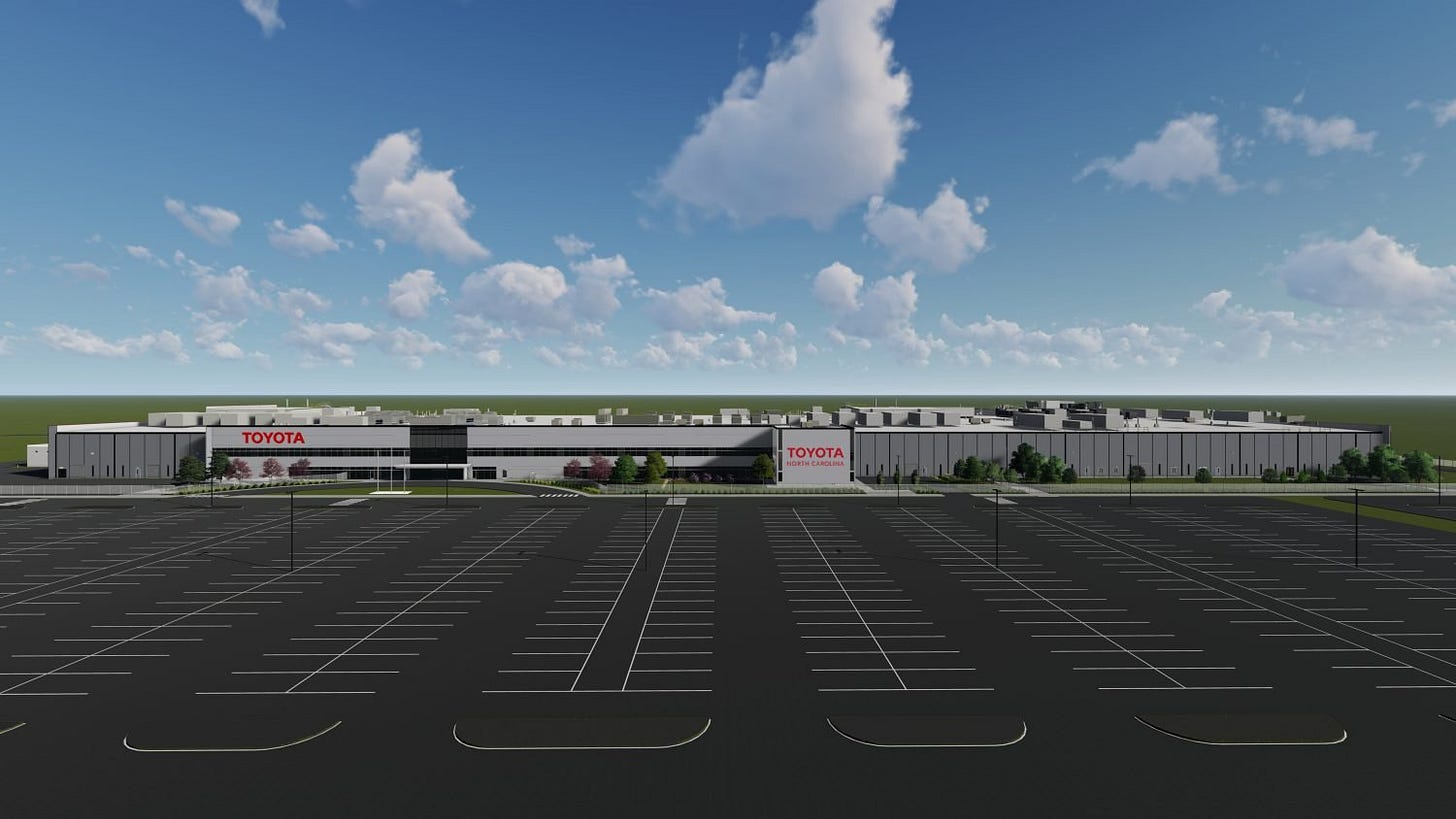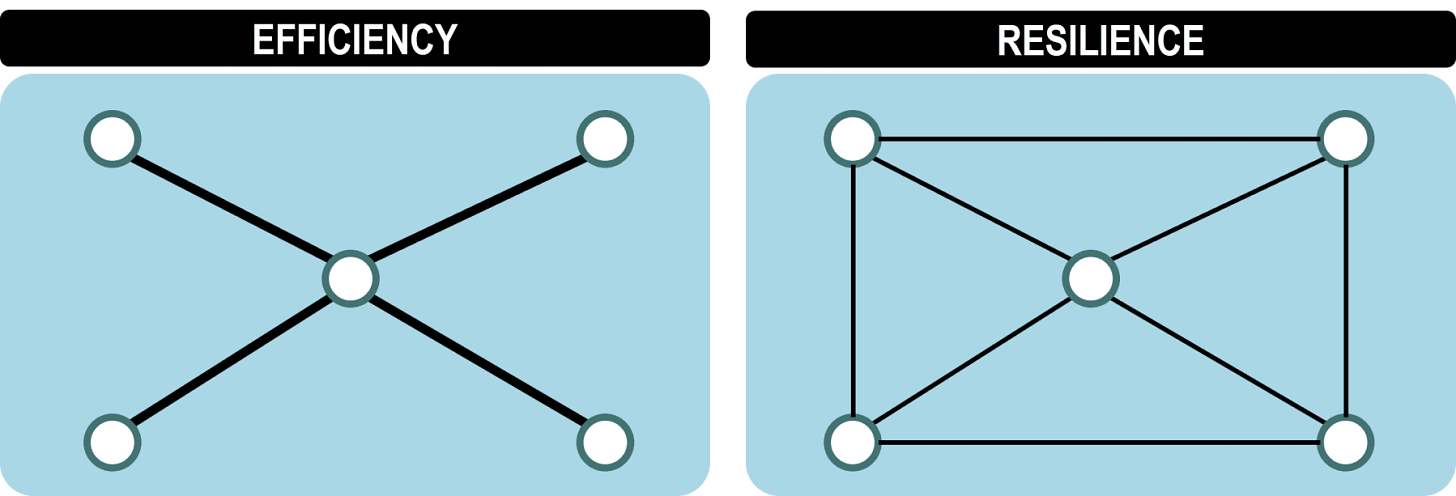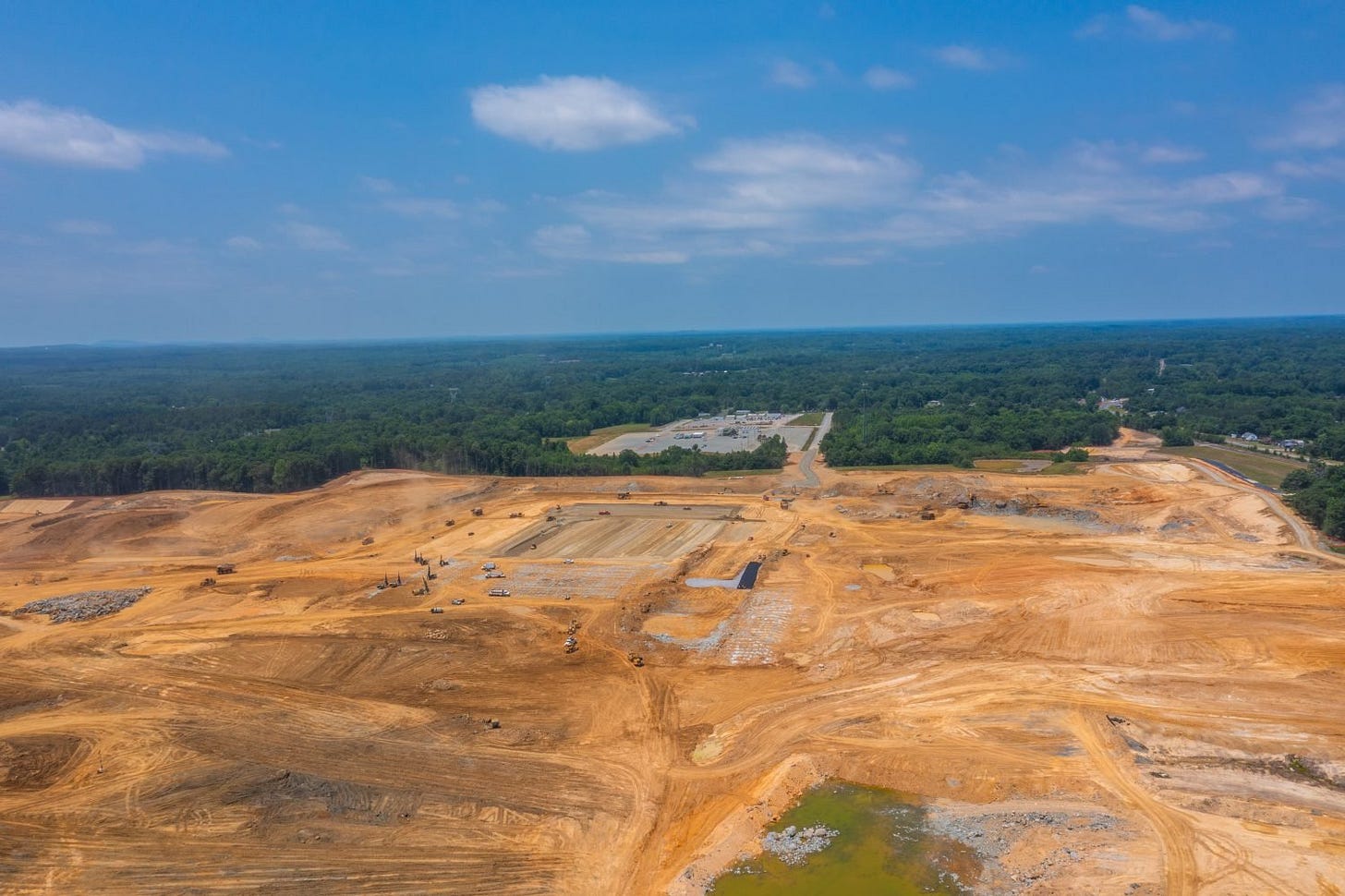Hello Interactors,
A series of U.S. federal legislation under the Biden administration has spawned a manufacturing boom at a scale not seen in decades. Unfortunately, the country is repeating the same socio-economic, land use, and transportation policy mistakes that have lead to many of the ills we’re seeking to remedy. Are we missing an opportunity to build back better?
A MANUFACTURING RENAISSANCE
Clearcut a forest and build a factory. Now build an even bigger parking lot around the factory for workers and make them drive from miles around to work. Parts and supplies? Yeah, those will have to be trucked in too. Now, stand here in front of the camera and wave this earth flag alongside a U.S. flag and brag about job growth and how EV’s are going to re-green the earth.

This scene captures what’s currently unfolding across the United States. Legislation such as the Infrastructure Investment and Jobs Act, CHIPS and Science Act, and the Inflation Reduction Act, alongside increased Department of Defense spending, is catalyzing a 'manufacturing renaissance' in the United States with a supposed emphasis on infrastructure improvement, clean energy, and national security.
Paradoxically, this familiar pattern in economic geography is partially responsible for the historical socio-economic inequities and environmental destruction the U.S. is struggling to remedy. Research by Drexel University’s Nowak Metro Finance Lab, in cooperation with the Aspen Institute’s Latinos and Society Program,1 is investigating the spatial dimensions of this shift, seeking to enhance opportunities for minority-owned businesses within this new economic landscape.
They’ve uncovered how the burgeoning manufacturing boom in the United States is showcasing a remarkable geographic distribution of investment and industry specialization significantly benefiting a diverse array of states and metropolitan areas. A substantial portion of funding aimed at bolstering the semiconductor supply chain is pouring into states like Arizona, Texas, New York, Ohio, and Indiana.

Additionally, to streamline supply chain efficiencies, battery plants are emerging alongside automotive factories in a vertical alignment from Michigan to Georgia. On the energy front, the Eastern seaboard is focusing on offshore wind power, while states such as California, Arizona, and Texas lead in solar panel production. This broad dispersion of high-tech manufacturing indicates a shift towards a more equitable distribution of economic growth across the nation.

This industrial transformation is not only geographically dispersed across many states and regions, but also spread to the outskirts of metropolitan areas. This raises challenges in harnessing this growth for the benefit of all, particularly Black- and Latino-owned firms and workers. It’s shaping into another form of ‘white flight’ where firms seek the cheapest land away from populated areas, which typically are exurban and rural farmland and forests, toward smaller cities and towns which are predominantly white. And mostly poor, offering a needed economic boost.

However, these regions, cities, and towns have also historically deprioritized public transit alongside decades of car dependent land use policies. So whatever jobs and growth these new manufacturing facilities bring, they’re destined to also bring more cars, which means more traffic, more pollution, and more time alone in cars isolated from interactions with community members. Meanwhile, the decades of neglect and decay of our rail network also means more truck traffic.

I’m reminded of geographer David Harvey's concept of the 'spatial fix'. It suggests capital movement, including the re-shoring of manufacturing, seeks new low-cost geographical frontiers to overcome drains on profit and expansion. This exploitation of geographical ‘space’ through industrial policy and investment reflects a 'fix' for capital investments and investors. By now, however, the meaning of the word 'fix' has less to do with a correction and more to do with an addiction.
There’s an addiction to a dynamic complex interplay of local and global economic geographies — a form of economic development and spatial restructuring that has shown to bring about both positive and negative outcomes. Parking lots and roads may have paved the way for many to cruise to a better quality of life, but the quality of the paradise we call home — our communities, cities, health, and environments — are suffering, if not lost, from decades of addiction.
This boom, while creating opportunities for some, may continue to be a bust for many. They may also spawn new forms of social stratification. The concentration of certain industries in specific regions, for example, could lead to a polarization of skill sets and economic opportunities. This, in turn, may result in localized booms benefiting a segment of society while leaving others behind, thereby reinforcing regional disparities rather than truly leveling the playing field and remedy the disparities that already plague this country.
Furthermore, the inter-regional competition for investment can spark a race to the bottom in terms of labor standards and environmental regulations. The suburbanization of industry, while beneficial for regional decentralization, often neglects urban cores leaving central areas, and underprivileged members of society, to grapple with the growing donut hole of decay from decades of lack of investment and attention.
This shift raises questions about the urban-rural divide, land use, and environmental sustainability. The dispersion of these new manufacturing initiatives does indeed offer opportunities for restructuring regional economies. There is potential for the country to move towards a multi-nodal metropolitan model where economic activities are spread across a wider area, including existing urban centers. Provided it is managed with an eye towards sustainability and inclusivity…and today it is not.
POWER, PEOPLE, AND PLACE
Now would be an ideal time to update and expand transportation infrastructure like rail and public transit to address decades of decay and neglect. By enhancing connectivity, metropolitan areas and their cities can become more resilient and inclusive, enabling a diverse workforce to access employment opportunities.
This would help mitigate socio-economic inequities while reducing car dependencies and the country’s outsized contribution to local, regional, and worldwide transportation related pollution. While renewable energy investments are worthy, as are roads, bridges, pipes, and electrical grids, most federal, state, and local transportation dollars are spent bolstering car sales and car dependency and all the physical, psychological, social, economic, and environmental health declines it’s shown to contribute to.
These infrastructure deficiencies underscore a more profound need for more adaptive strategies that align with principles found in complexity science, like resiliency. The resilience of these increasingly brittle social systems is tested not only by burgeoning demands but also by the unpredictable shocks like those experienced during the pandemic.
Increasing frequency and amplitude of weather shocks also reveal the fragility of underinvested frameworks. The capacity to adapt to emerging needs and stresses — be it climate change impacts, congestion, or energy supply — requires a systemic rethinking that transcends traditional silos of urban planning and regional economic development.

Moreover, the underrepresentation of minority-owned firms in strategic sectors, as still found in federal spending patterns, hints at an oversight resulting in an exasperation of existing inequalities and social tensions. As the report demonstrates, these will likely persist unless addressed through targeted interventions. As we learned with the BLM movement, and similar social movements in the past, interventions must start by understanding lived experiences and power relationships on the ground, locally and regionally. This is essential to building the socio-economic political systems that enable or disempower them.
Space and place are often viewed by the powerful and by policy makers as neutral, abstracted points, polygons, and numbers on a map or spreadsheet. But they’re more than that.
The work of geographer Doreen Massey reminds us space is a product of interrelations and interactions at all scales across institutions and individuals and therefore can’t be regarded as neutral. In her influential book “Space, Place and Gender” she reveals how space is politically and socially charged — imbued with power relations. She introduced the idea of "power geometry" to describe the complex and dynamic ways in which different social groups and individuals are positioned within the "flows" of the globalized world.

Recent global events and current local investments across the country are examples of power geometry. We can see how different social and political groups have distinct relationships with these new flows and movements — how they are able to command space and assert influence over it. Some have the power to shape networks and connections across space, which includes the ability to accelerate the pace of movement and interaction for themselves, while others are placed in positions where they are restricted or excluded. This can be true even for those who can afford to own cars and those who cannot.
Owning a car, while a necessity for most, is still a form of power that when asserted only serves to diminish the power of those who do not. Many of these new manufacturing hubs are being built to build more cars and computer chips for them by people who need cars to get to work. This reveals the powerful influence the federal government has over the global geographic geometry required to build cars, and their parts, the local geometries needed to build the plants, and the car dependent network of roads needed for employees. Cars are miraculous modern appliances until they are concentrated within clustered collections of cities which then become problem areas for which firms seek a spatial fix.
Even as federal investment feeds the manufacturing of more cars, along with more regional development that requires more roads and maintenance, society laments climbing car related deaths, worry about the effects of social isolation that can lead to decreased physical and mental health, stress over income disparities, all while watching a polluted planet burn. It all seems as counter intuitive as it does counterproductive. The more we invest in perpetuating car dependency the less money and attention is put toward more healthy and resilient alternatives.
As this new industrial sprawl unfolds, sustainable transportation becomes increasingly vital for connecting industrial zones with urban centers, addressing the dislocation of workspaces, and fostering economic and social robustness and resiliency. We need to urge policymakers to consider the broader implications of the current manufacturing boom on the social fabric of the nation.2 If we don’t take a comprehensive, diversified, and integrative approach to planning our regions and economies we not only risk perpetuating existing social and environmental woes, but also suffering collapse from another unforeseen emergent disaster.
The Industrial Transition and the US Metropolis. The New Localism. Bruce Katz, Milena Dovali, Avanti Krovi, and Victoria Orozco. May, 2023.
At a recent visit to Hunter College, Secretary of Transportation Pete Buttigieg calls for continued EV investment, but also calls for added investment transit. He also hints at potential investments, including public and private partnerships, in High Speed Rail.













